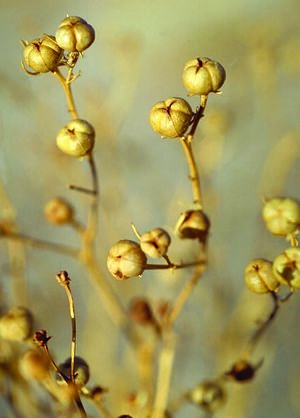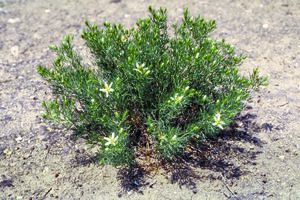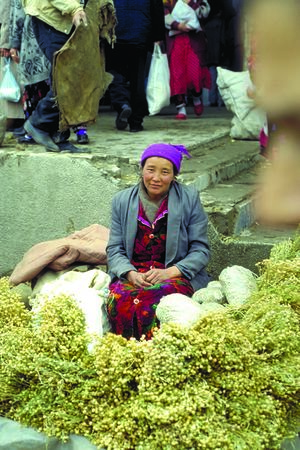Peganum harmala (Gintzburger et al., 2003)
| Peganum harmala (Gintzburger et al., 2003) |
Local name:
- Russian: Гармала обыкновенная (могильник, дикая рута) - garmala obyknobennaja (mogil'nik, dikaja ruta)
- Uzbek, Kazakh: Issirik, Adraspan, Isfent, Hazarasband
- Tadjik: Hazorispand
- Turkmen: Yuzarlik, Izarlik
Chromosome number: 2n = 22 (Negodi 1937); 2n = 24 (Warburg 1938).
Description and morphology: Perennial, short (hemispherical) herb or shrub (height 30– 50 cm), contrasting green, glaucous, with woody base, strong characteristic smell. Strong pivotal root system (to depth 180 cm). Stem: numerous twisting or erect, glabrous much-branched from base. Leaves: numerous (3–8 cm), sessile, opposite, glabrous, fleshy, blade irregularly pinnatisected; lobes linear, entire, acute. Stipules (1–2 mm), subulate. Flowers: bisexual; large (2–4 cm), white-yellow, regular, pedicelled, solitary or paired in terminal cymose inflorescence. Sepals (1–1.5 cm), narrowly linear, sometimes with 2 small lateral lobes; 12–15 stamens dilated at base, inserted in whorls (3–5) in 3 rows at base of cup-shaped disc. Pollen grain 2-celled and 3- colporate. Ovary superior, 3-locular, globose with numerous ovules. Stigmas: lobed on short style.
Reproduction: Sexual. Entomophilous. Flowering: May–July. Fruit maturation: August– September. Fruit: dry loculicidal or dehiscent capsule (5–8 mm), pale brown, sub-globose 3-valved, with membranous or slightly sclerified fruiting body. Seed: numerous (more than 30), small (1.5–4.4 mm), flattened, triangular, tuberculate, dark brown with direct or slightly bent embryo, surrounded by endosperm. Seed coat thin, lustreless, tuberculate. Dormancy B1 type. Germination (at 28–30 °C and light cycle): 32–41%. Chemical treatment with thio-urea or kinetin stimulates germination.
Pastoral importance: Poisonous. Not touched by livestock when green; its presence (2–3%) in silage also causes poisoning. Occasionally grazed in autumn-winter when dry, but poisoning may still occur. An indicator of overexploited- overgrazed rangeland and recent human settlement.
Fodder value: None in spite of its excellent chemical composition. At flowering (% DM): crude protein 24; fat 3.7; ash 18; cellulose 18; nitrogenfree extract 31. Alkaloids concentrated in roots and seeds (about 5%, of which harmin 30%).
Economic interest: Largely used in traditional medicine (as emmenagogue, emetic and diuretic). Rich in alkaloids (harmin and harmalin). Potential for use in pharmaceutical industries. Commonly used as an insecticide (fumigation of houses, barns, etc.). Also a colorant-dye (dark red).
Habitat: Ruderal xerophyte. Anthropogenic. Nitratophilous. Found in overgrazed areas, disturbed sites, roadsides, populated settlements, wells and cattle-yards. Occurs on clay to sandy loam flats as single plants or in large monospecific plant communities on overgrazed sites (e.g. many thousand hectares between Karnab-Tym and Tutlee-Hakkar area recorded in spring 2000).
Distribution: Irano-Turanian region and Saharo-Arabian; all arid and semi-arid Mediterranean region, southern Euro-Siberia, Middle Asia, southern Kazakhstan, Caucasus, South Russia, Siberia, Indo-Himalayas and West Mongolia.


